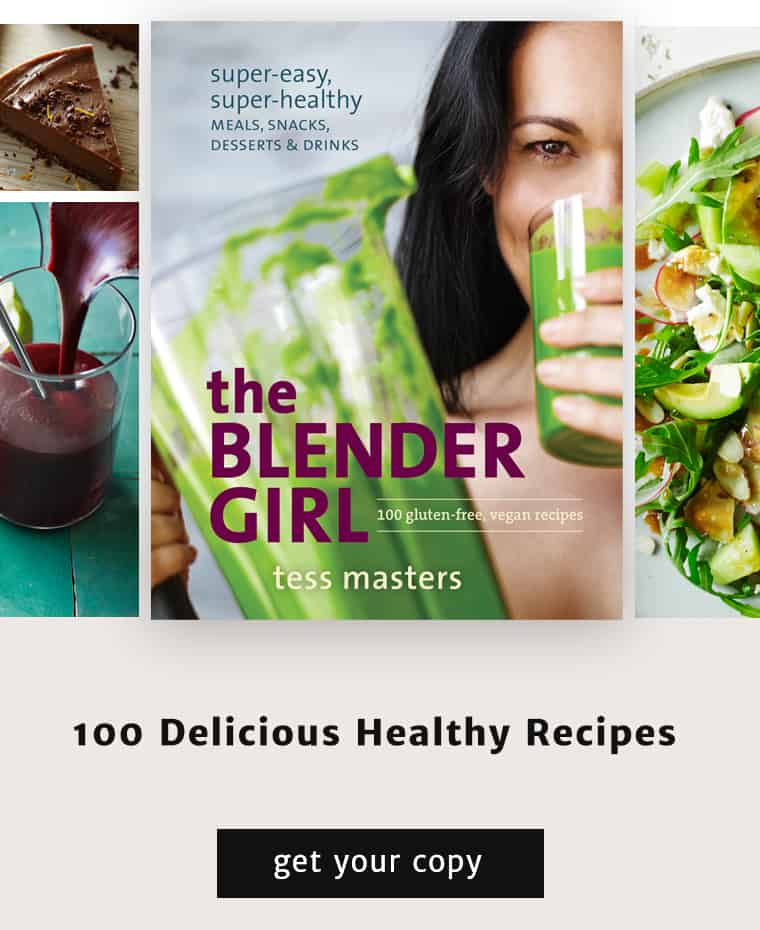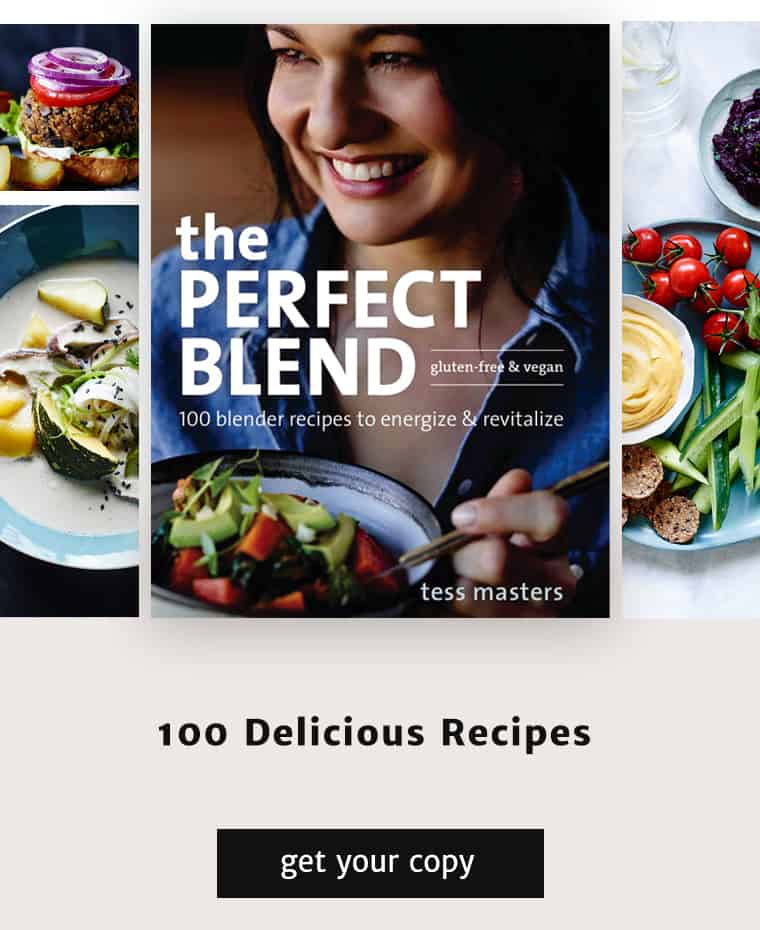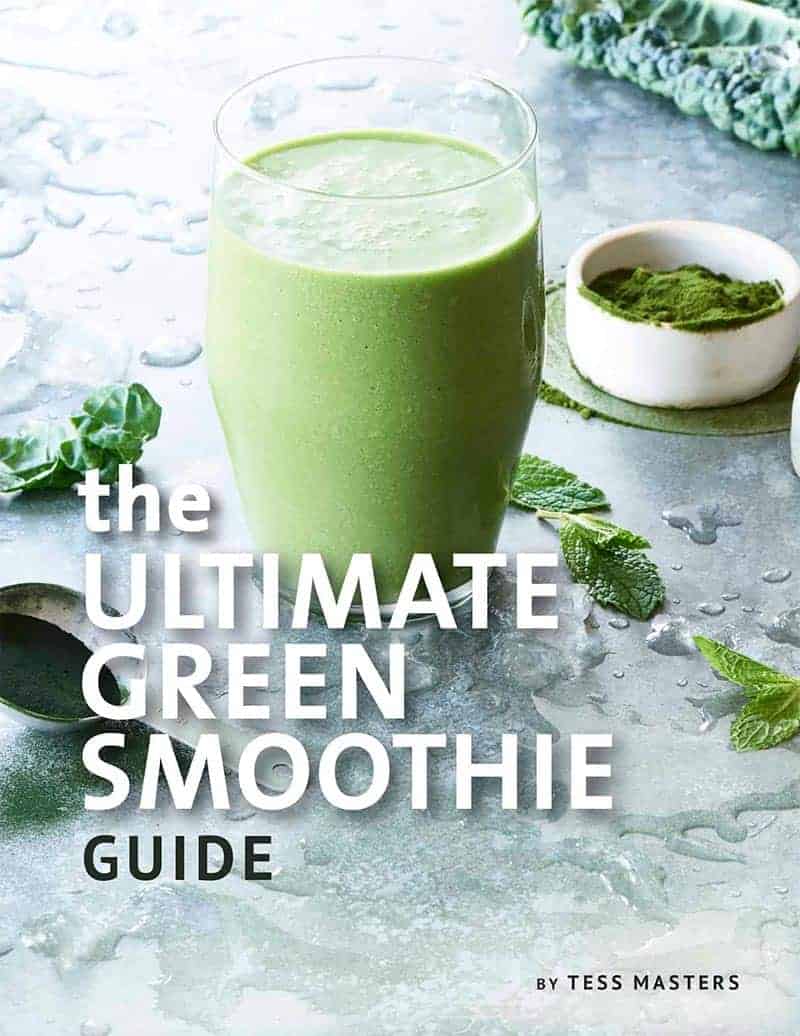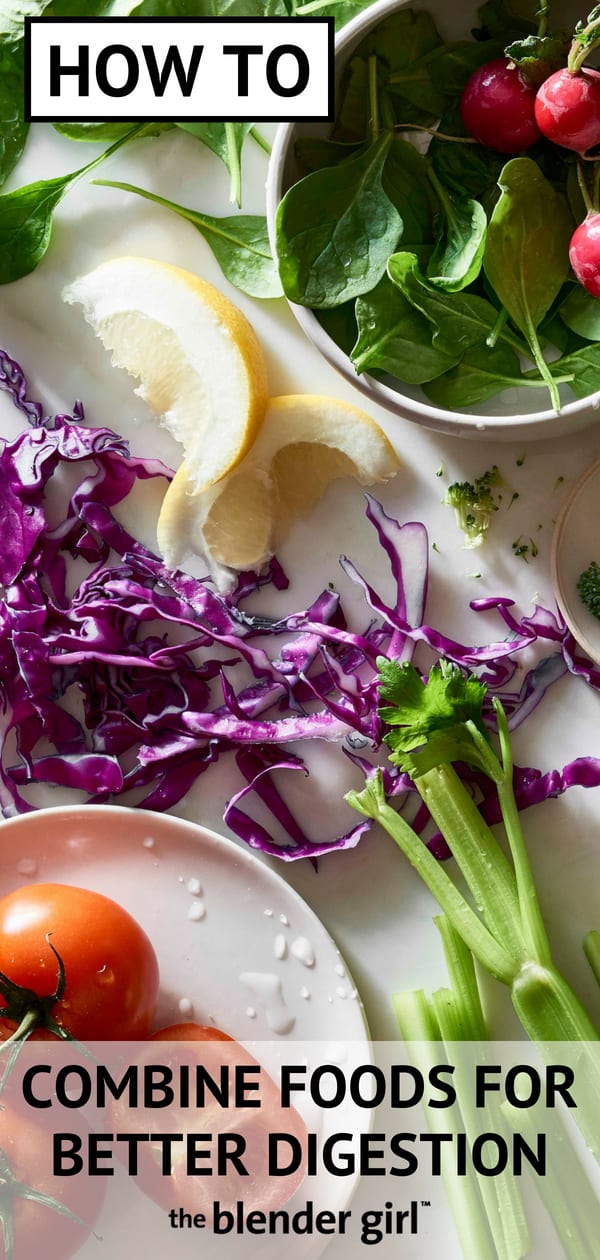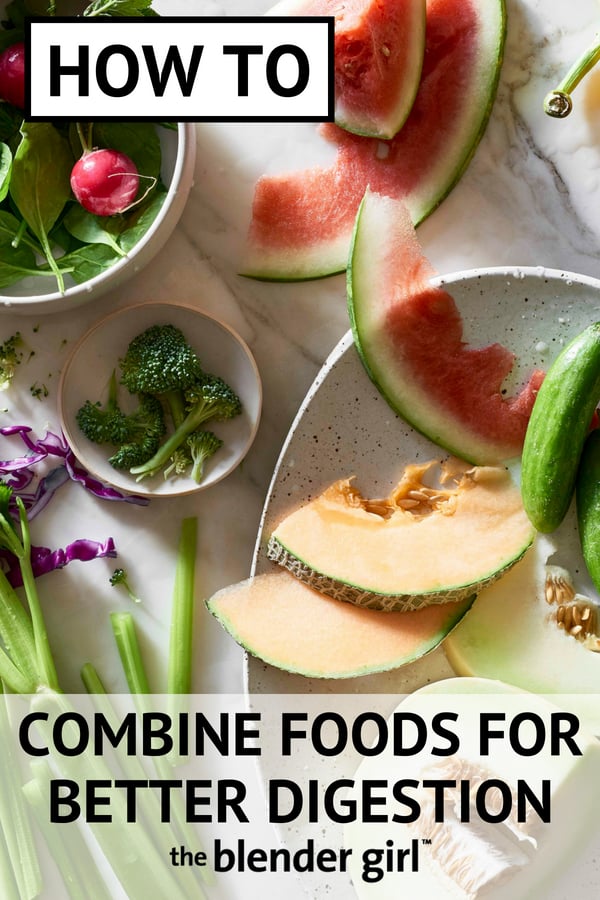Food Combining
Use this simple guide with food combining charts to strategically combine foods for better digestion and health.
Food Combining
Food combining is an approach to eating that strategically pairs foods to support better digestion and gut health.
If you experience gas, bloating, acid reflux, GERD, or other digestive problems, food combining can be a really effective strategy for managing, improving, and even eradicating some of these health issues. Better food combining can also support weight loss! And, if you suffer from candida (an overgrowth of yeast), mindful food combining is a powerful tool to support your recovery.
What I love about food combining is that it is NOT a “diet”. You don’t have to “give up” your favorite foods, starve yourself, or feel miserable and deprived. Rather, you simply rethink how you put foods together!
Here is some basic information about food combining to help you incorporate better food combining in your life.
I have created some free food combining charts to make it really easy to follow the basic principles.
DOWNLOAD your FREE Food Combining Charts.
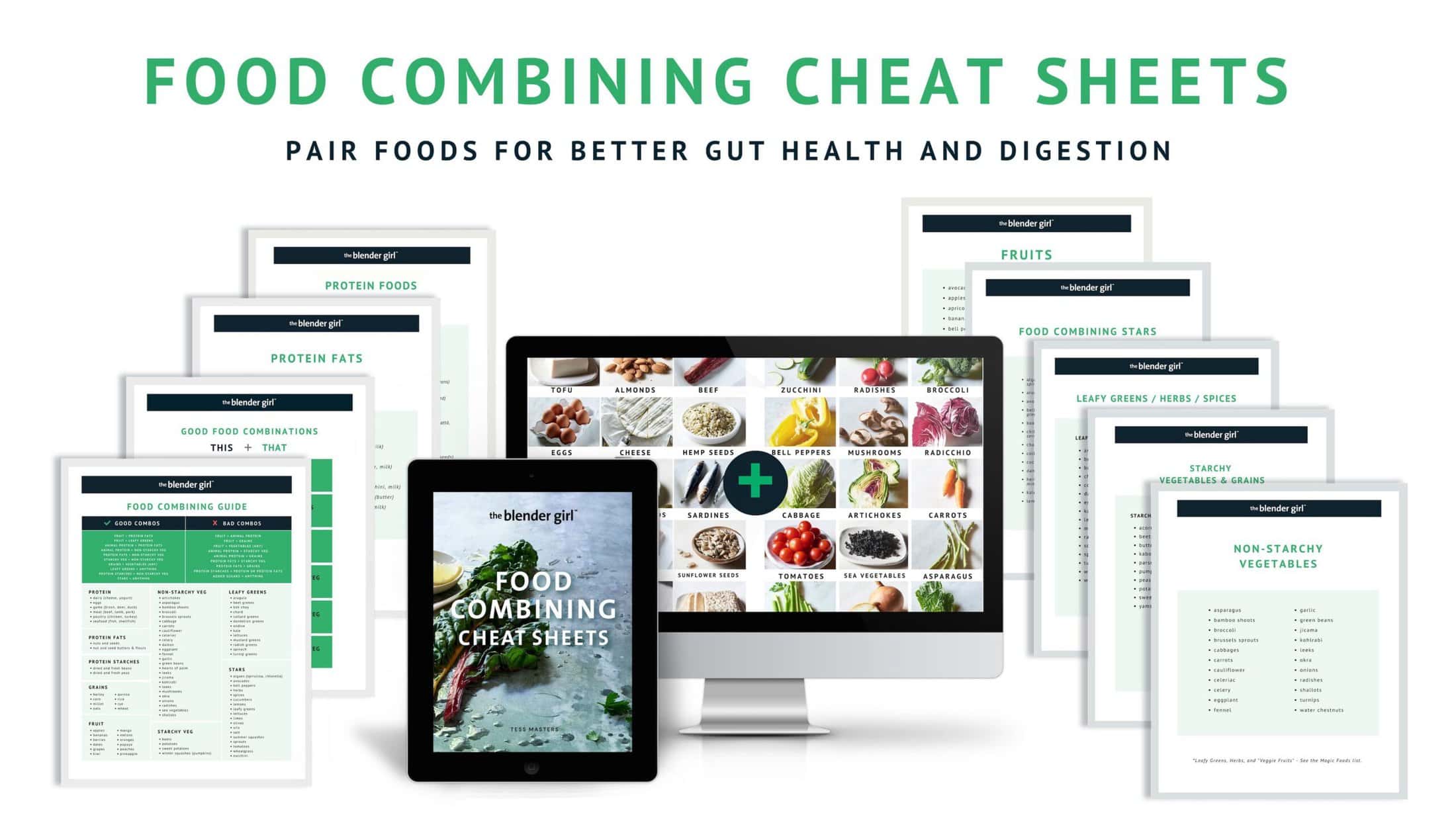
Poor Food Combining
A good way to open up the larger food combining conversation is to look at some classic food combinations that you are probably eating, and talk about why these combinations may be causing problems in your body.
So, let’s look at some traditional Western combos that pair proteins with starches:
- Meat + Potatoes
- Chicken + Biscuits
- Spaghetti and Meatballs
- Grilled Cheese Sandwiches
- Fish + Chips
- Hot Dog
- Hamburgers
And the list goes on.
Eating any of these combinations requires the starch and protein digestive processes to work at cross-purposes.
What essentially happens is that they neutralize each other. Neither the protein nor the starch gets handled effectively in your digestive system, which leads to fermentation in your gut, which feeds bad bacteria, yeast, fungi, and other hostile microbes.
You cannot achieve better health without better digestion. So, if your gut is in trouble, the rest of your health is in trouble.
Poor digestion puts a strain on the liver, your all-important regenerative and detox organ, which you need working at its best or you get sick!
Food Combining Basics
Food combining works on the premise that our bodies can only digest one concentrated food at a time. Concentrated foods are defined as starches and proteins. So, to simplify it, any foods other than fruits and vegetables.
The idea behind strategic food combining is that the digestion of starches (grains, pseudo-grains, potatoes, sweet potato, beets, and many other roots) requires alkaline conditions, whereas the enzymes that digest proteins thrive in a more acidic environment.
So, when you eat a starch and a protein together, you’re essentially asking your digestive system to be alkaline and acidic at the same time. Unfortunately, many traditional food combinations require our digestive system to work at cross purposes! This process causes a chain reaction that disrupts the digestion of all the foods you eat.
But, food combining isn’t quite as simple as just watching your proteins and starches. There are also categories of foods that combine best with certain other foods, and I will explain the different categories in this post.
Please read this entire post and give food combining a try because it is such an incredible strategy.
Yes, it may seem confusing at first because the food combining recommendations go against many of the combinations we typically enjoy in most cuisines. But, once you understand the basic principles (which I will explain in this post), food combining is actually really easy!
DOWNLOAD your FREE Food Combining Charts.
Symptoms or Poor Digestion
Do you experience any of these symptoms or poor digestion?
- gas
- bloating
- stomach pains
- indigestion / acid reflux / GERD
- irregular bowel movements
- bad breath
- skin issues
- disrupted sleep
- fatigue
Do you feel tired after you eat? Lack of energy can be due to several factors such as blood sugar drops, a need for more sustenance, nutrient imbalances, and other health issues.
But often, fatigue is a sign of poor digestion and gut health, and if your fatigue IS due to digestive issues, strategic food combining (along with other strategies) can really help you to feel better quickly!
Practicing strategic food combining can, in many cases, dramatically improve or even eradicate these health issues because better food combining helps to improve your nutrient absorption, digestion, and gut health; supports weight loss and detox, and can improve your energy levels.
I have been utilizing food combining principles in my personal life for over 25 years, and I can personally attest to the power of this practice.
I suffered with the stereotypical vegetarian “lentil gas” and severe bloating (where I had to lie on my stomach to get rid of the gas), and after implementing food combining in my daily life, I don't have gas and bloating, I sleep through the night, and I wake up with lots of energy…even during menopause. And, this can happen for you, too!
And, just to give you hope, I have the data to prove how powerful food combining is!
Food combining is a core strategy in my 60-DAY RESET. This program is a digestive reset facilitated by my team of dietitians, where we use better gut health to improve overall health. I developed over 300 recipes that are all anchored in food combining principles and the health transformations have been incredible!
Thousands of people have reduced and eradicated gas, bloating, constipation, acid reflux, and GERD; regulated their blood pressure, cholesterol, and blood sugar; improved their sleep and energy; and lost weight with the power of food combining and other simple strategies.
Be open to trying food combining, because this CAN work for you, too!
So, here are the core principles so you can give it a try.
DOWNLOAD your FREE Food Combining Charts.
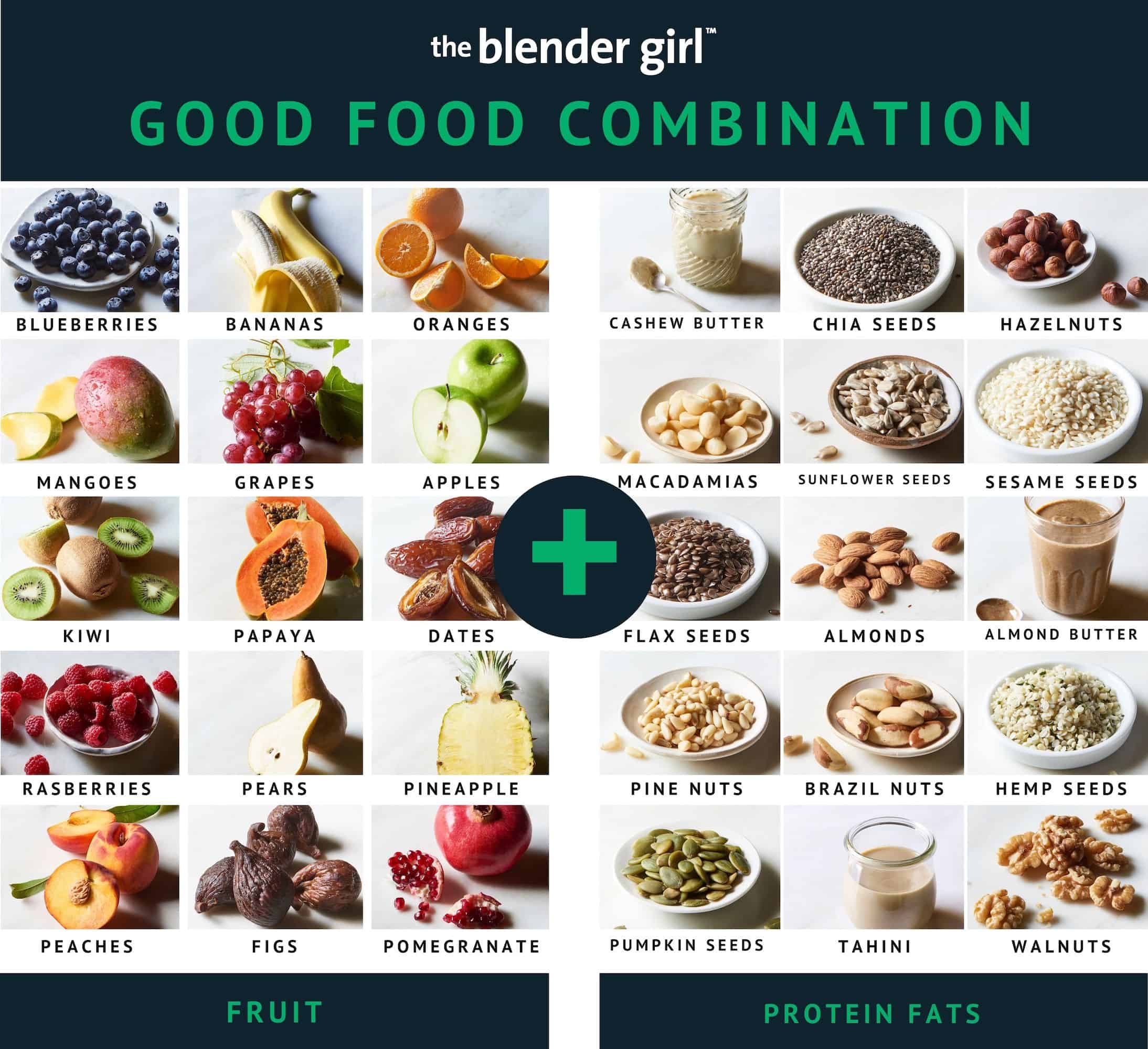
Food Combining Principle #1:
Combine Fruit with Protein Fats (Nuts and Seeds) and/or Leafy Greens
Many years ago in the 1980's when the famous food combining book FIT FOR LIFE by Harvey and Marilyn Diamond was released, food combining purists suggested that the best way to consume fruit was on its own in the morning to support better liver function.
Your liver works hardest to eliminate toxins between midnight and midday. Digesting fruit doesn’t require action by the liver, so to support better detox and elimination traditional food combiners consumed only fruit before noon as fruit is a great replenisher of fluids after a night of rest and moves quickly from the stomach into the small intestine. A fruit breakfast leaves the stomach ready for a more varied lunch.
However, eating fruit on its own can be problematic in terms of blood sugar levels, insulin sensitivity, and energy levels. While fruit provides quality carbohydrates with fiber, vitamins, minerals, and antioxidants, it does not provide quality fats and protein for balanced nutrition.
My dietitians and I do not advocate eating fruit on its own as the natural sugar can cause blood sugar spikes followed by crashes which manifest as blasts of inflammation, and creates fatigue - that mid-morning or mid-afternoon slump. These spikes and crashes put a strain on your liver, kidneys, and other organs; and damage your tissues and cells. Fruit also does not sustain most people until the next meal or snack. So, you could feel hungry a lot!
Consume Fruit With Protein Fats and/or Leafy Greens
We recommend consuming fruit with some protein fats (nuts and seeds) to slow down the assimilation of sugars to regulate blood sugar and give you a sustained release of energy, and help you to feel full.
Fruit combines well with protein fats (nuts and seeds), leafy greens (spinach, kale, bok choy, chard), plant fats (oils), and any of the magic/star foods (avocado, cucumber, lemons, limes etc).
A Note About Melon
Other fruits move through the body in about 30 minutes, and bananas and pears typically take about 40 minutes. However, melons move through the body in about 20 minutes, faster than any other food, hence the food-combining motto: “Melon on its own or leave it alone.”
Many people experience extreme gas and bloating when eating melon, particularly when they consume melon with other fruits in a smoothie or with nuts and seeds. Experiment, and see what works for you. You may be able to tolerate a small bit of melon, but not a large portion.
Do Not Consume Fruit With Animal Protein, Legumes, Beans, Or Starches
Unfortunately, fruits (except for the magic/star fruits) do not combine well with concentrated starches and proteins, which typically take three to five hours to digest. If you eat fruit with starches and proteins, fruit gets trapped in the longer digestive cycle of concentrated food, and it ferments and produces acid and alcohol which feeds yeast, fungi, and hostile bacteria, and can impede better digestion.
The Timing of Fruit Consumption
When consuming fruit, be mindful of adhering to food combining principles. To support better digestion, food is best consumed with other fruit, nuts and seeds, leafy greens, and foods on the magic/star list. Beyond pairing foods with fruit in the same meal or snack, pay attention to the timing of your fruit consumption. After eating fruit with nuts, seeds, and/or leafy greens, wait about 60 minutes before consuming animal protein or non-starchy vegetables. After consuming animal protein, vegetables (starchy or non-starchy) or grains, wait at least 3 hours, preferably 5 hours before consuming fruit.
Vegetable Fruits Combine Well With Everything
“Vegetable fruits” such as avocados, cucumbers, tomatoes, bell peppers, and olives are classified as "magic" or "star" foods and can be eaten with any other foods: Other fruits, vegetables, starches, and proteins. Leafy greens (spinach, kale, collard greens, chard, bok choy), along with the vegetable-fruits noted above, are our go-to staples.
DOWNLOAD your FREE Food Combining Charts.
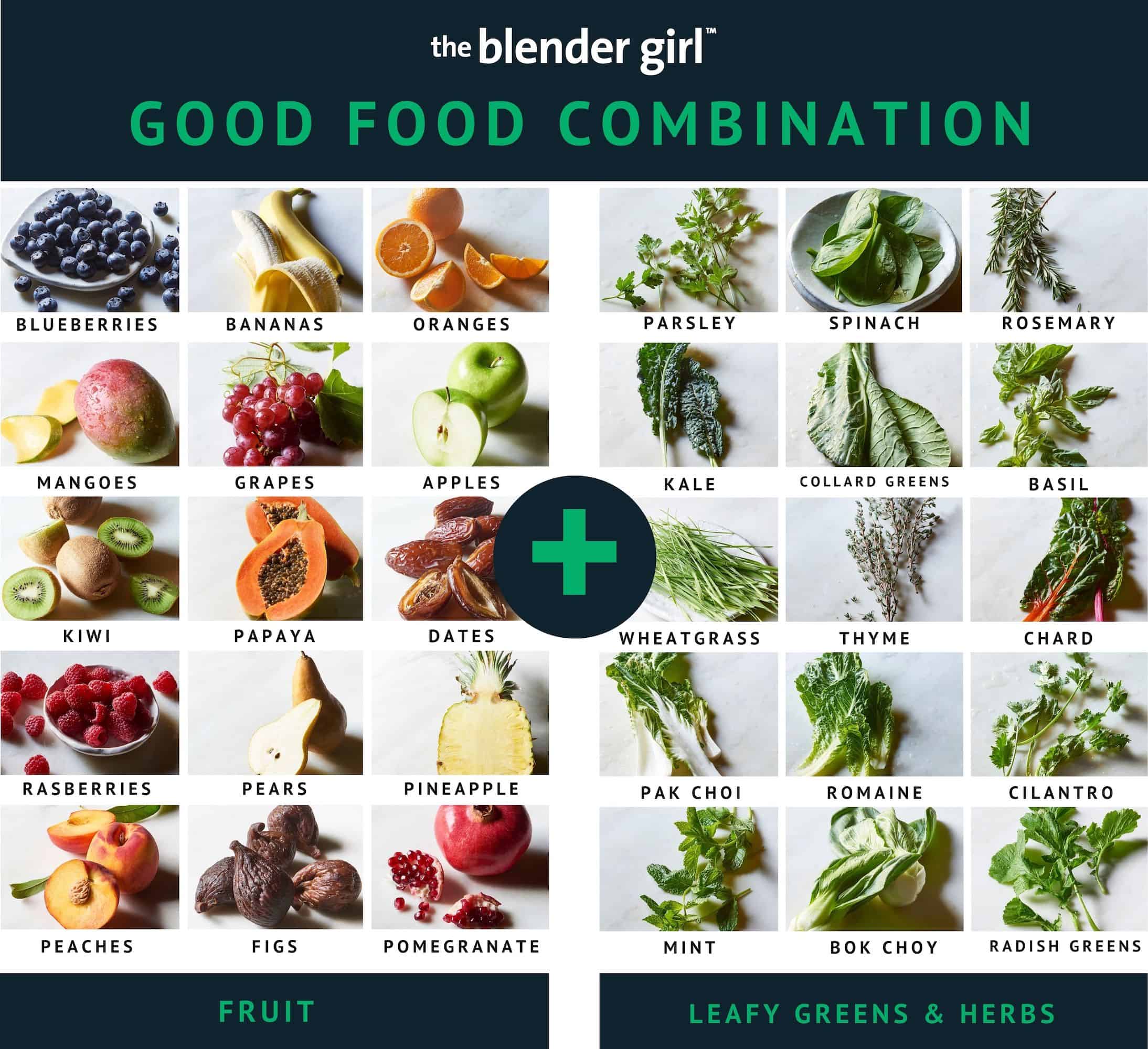
Food Combining Principle #2:
Combine Protein with Non-Starchy Vegetables or Sea Vegetables
When you eat proteins such as:
- meat
- fish
- poultry
- eggs
- nuts
- seeds
- beans / legumes
Your stomach cranks up the hydrochloric acid and the protein-digesting enzyme pepsin which is not a good environment for the digestion of starches.
Proteins are best combined with non-starchy vegetables such as:
- leafy greens (spinach, kale, chard, bok choy, arugula)
- lettuces (butter, romaine)
- broccoli
- cauliflower
- cabbage
- brussels sprouts
- asparagus
OR with sea vegetables:
- nori
- kombu
- wakame
- dulse
All of all these foods happily digest in both a protein or starch-friendly environment.
TIMING: Leave at least 3 hours between a protein meal and a starch meal (potatoes or quinoa) to support better digestion.
DOWNLOAD your FREE Food Combining Charts.
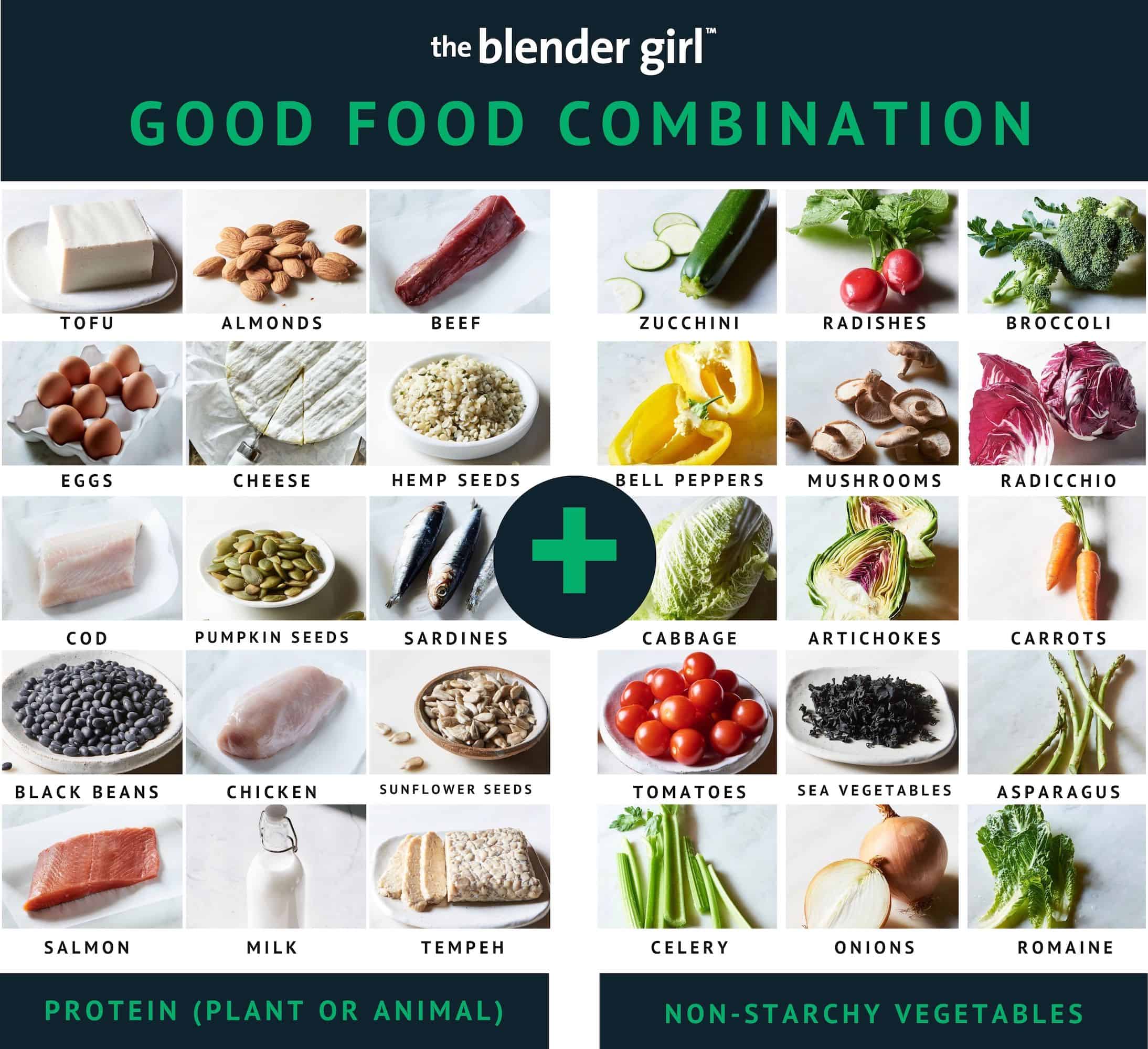
Food Combining Principle #3:
Combine Protein Fats (Nuts and Seeds) with Non-Starchy Vegetables
Protein Fats such as:
- nuts (almonds, walnuts, pecans, cashews, hazelnuts, pistachios, macadamias, Brazil nuts)
- seeds (hemp, chia, flax, sunflower, pumpkin, sesame seeds)
- dairy (milk, kefir, cheese, yogurt)
These foods combine best with non-starchy vegetables such as:
- leafy greens (spinach, kale, chard, bok choy)
- cabbage
- broccoli
- cauliflower
- asparagus
- brussels sprouts
OR, with fruits:
- lemon
- lime
- grapefruit
- berries
- kiwi
- pineapple
- mango
- bananas
- dates
NOTE: Do NOT combine fruits with non-starchy vegetables to support better digestion.
TIMING: Leave at least 3 hours between a protein meal and a starch meal (potatoes, winter squashes, beets, or grains).
DOWNLOAD your FREE Food Combining Charts.
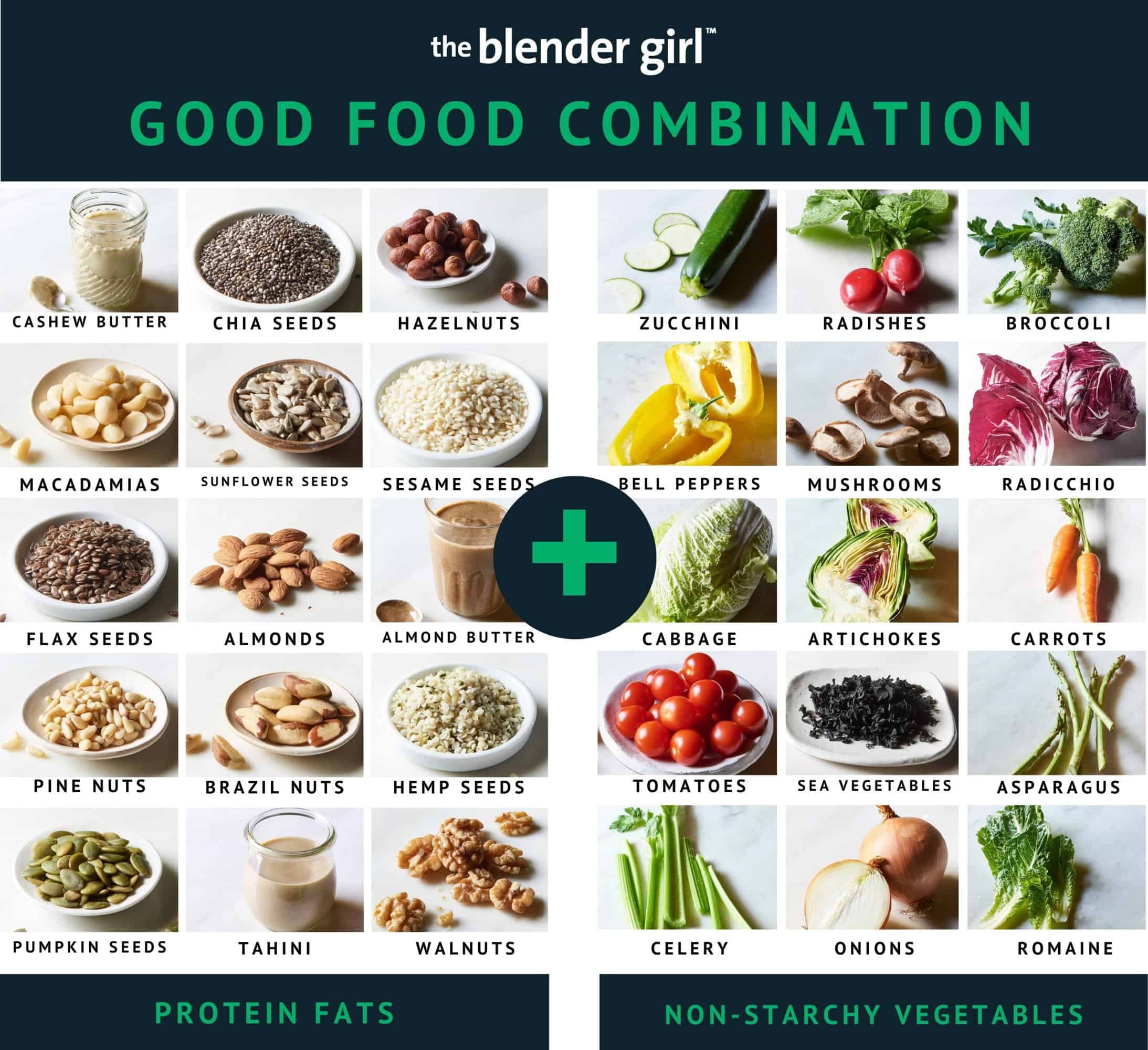
Food Combining Principle #4:
Combine Grains and/or Starchy Vegetables with Non-Starchy Vegetables
Non-grain starches such as:
- beets
- corn
- potatoes
- sweet potatoes
- winter squashes (butternut, kabocha, pumpkin)
can be combined with grains and pseudo-grains such as:
- rice
- quinoa
- millet
- oats
- buckwheat
- amaranth
- sorghum
and other grains.
These starchy foods also work well with non-starchy vegetables such as:
- leafy greens (spinach, kale, chard, bok choy)
- broccoli
- cauliflower
- brussels sprouts
- asparagus
- sea vegetables (nori, dulse, wakame)
Classic duos like vegetable curry with grains, pasta with tomato-based sauce, and baked potatoes with salad or coleslaw go together not only for flavor and texture, but also for better digestion.
TIMING: Leave at least 3 hours between a starch-based meal and a protein-based meal.
DOWNLOAD your FREE Food Combining Charts.
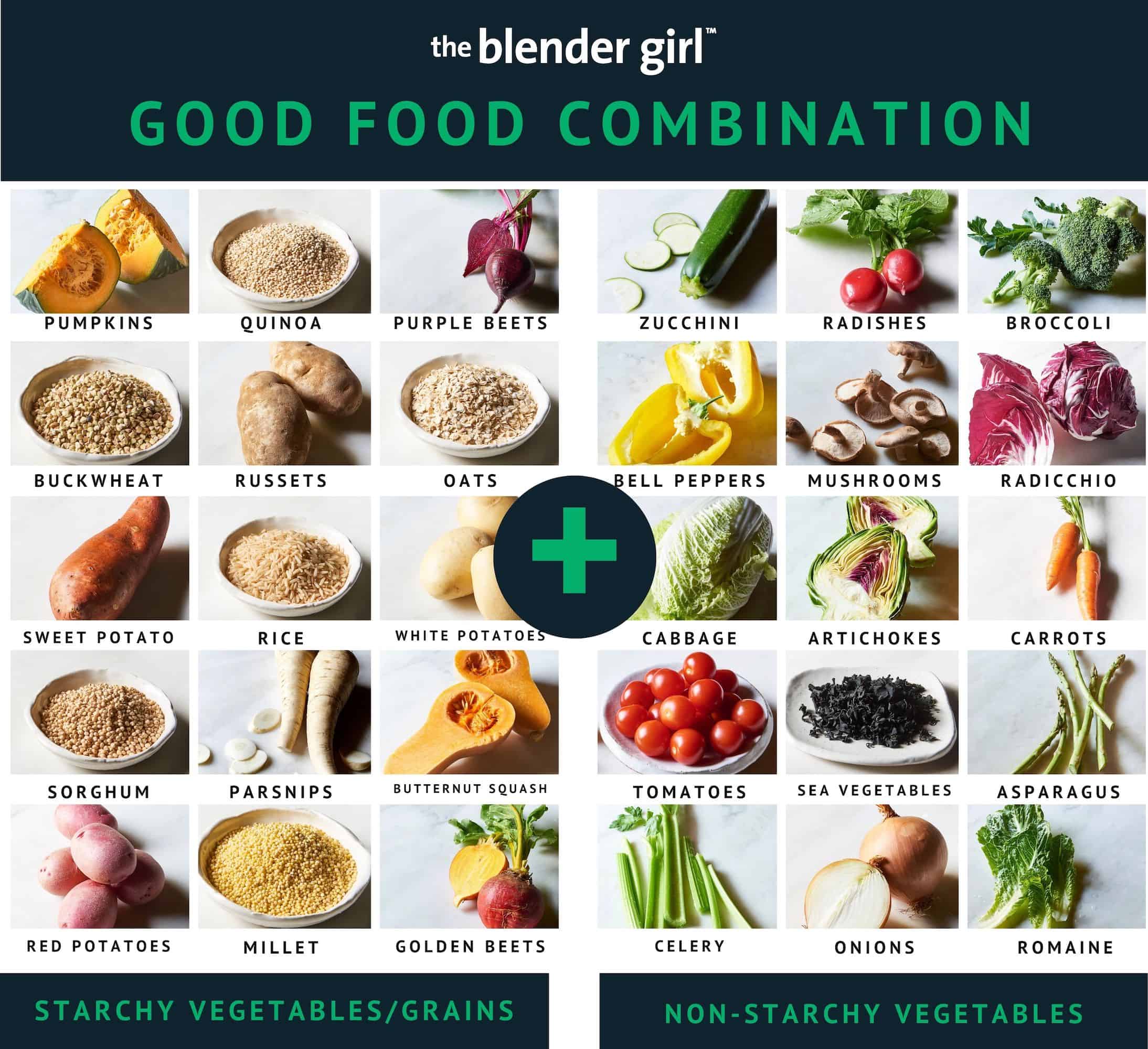
Food Combining Principle #5:
Combine Protein Starches (Beans/Legumes) with Non-Starchy Vegetables
Beans and Legumes are a fantastic source of high quality plant protein, complex carbohydrates with loads of fiber and resistant starch, vitamins, minerals, and beneficial compounds that can support better heart health, brain health, and weight management.
However, from a food combining perspective, beans, peas, and lentils deliver concentrated proteins AND starches. So, these foods are known as "protein starches" for food combining purposes.
These foods are difficult to digest, and many people experience gas, bloating, and fermentation in the gut.
SOAKING AND COOKING: Beans contain phytates that inhibit the digestion of key nutrients such as calcium and iron. To support better digestion, we recommend using dried beans and soaking them in filtered water with a strip of kombu (seaweed) to neutralizes the enzyme inhibitors, release some gas, and help the protein to become more available. Soaking also softens the beans so they cook more quickly and evenly.
LECTINS: Lectins are proteins that bind to carbohydrates that are found mainly in legumes and grains, but also in most plant foods including nightshades, nuts, and seeds. Cooking beans (particularly in a pressure cooker) deactivates lectins. However, for people with digestive sensitivities and gastrointestinal problems, lectins can compromise the gut microbiome, and absorption of nutrients, decreasing acid secretion, and increasing inflammation. So, monitor your reaction to beans.
CANNED BEANS: For better digestion and better health, we do not recommend consuming canned beans. These beans have not been soaked to activate their full nutrient potential, have been cooked quickly, and are often packaged in their cooking liquid which contains some anti-nutrients that impede better digestion.
FOOD COMBINING: To support better digestion, do not consume beans with animal protein or plant protein (nuts and seeds).
Beans are best combined with leafy greens and non-starchy vegetables.
Monitor your response to beans. You may find that you can tolerate certain beans and not others, and you may also discover that you can tolerate small quantities but not large quantities in one sitting.
DOWNLOAD your FREE Food Combining Charts.
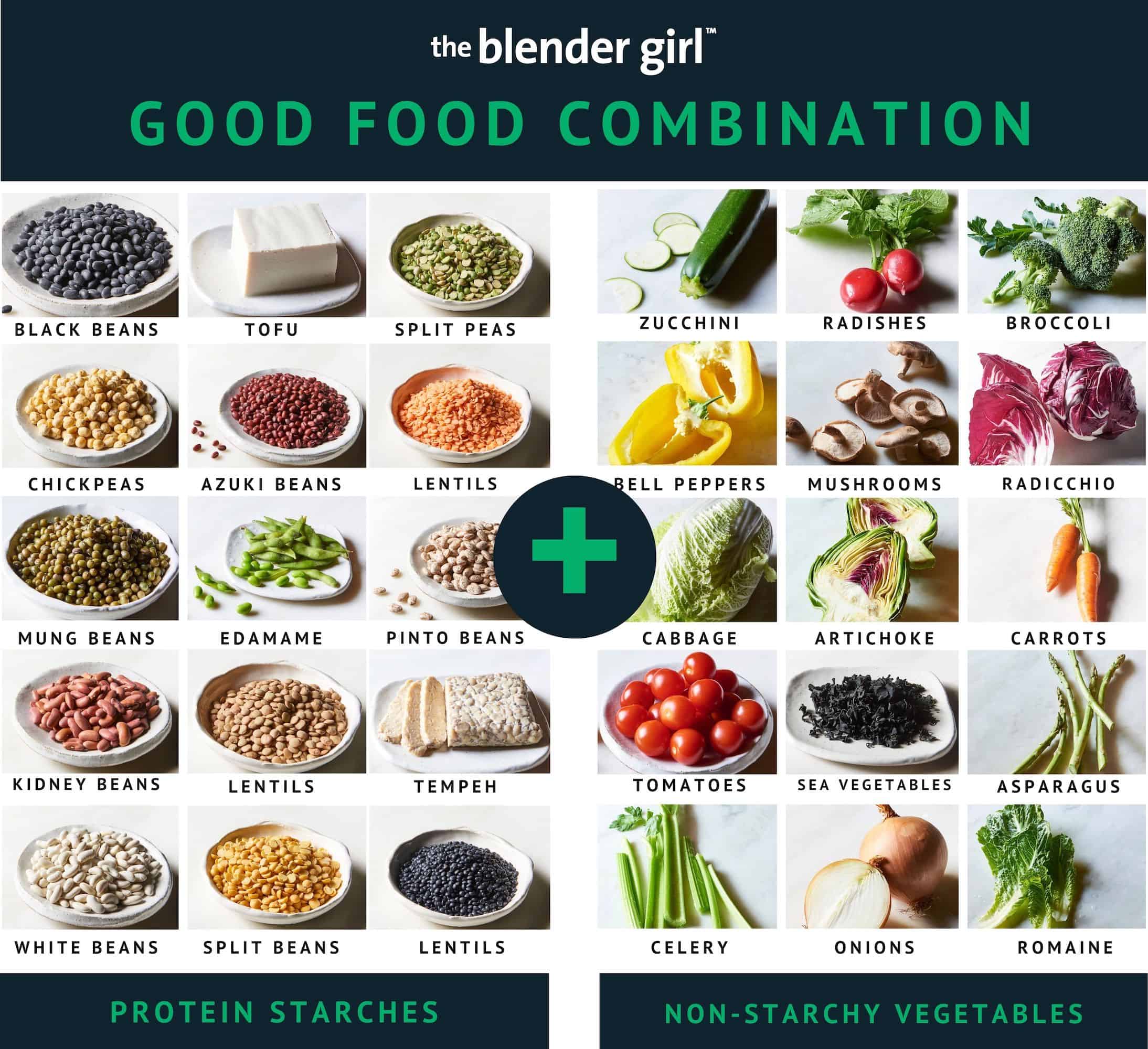
Food Combining Principle #6:
Star / Magic Foods Go Well with ANY FOODS!
These flavorful foods (that we call the Food Combining Stars or "Magic Foods") combine well with ALL FOODS, making food combining so much easier!
And, an added bonus is that these are really health foods that should loom large in your diet anyway.
We recommend keeping a variety of these foods on hand to throw together quick meals and snacks.
- leafy greens (spinach, kale, chard, collard greens, bok choy)
- lettuces (butter, romaine, arugula)
- herbs (basil, mint, parsley, cilantro, tarragon)
- spices (cinnamon, ginger, turmeric, cayenne)
- lemon
- lime
- avocado
- coconut
- tomatoes
- cucumbers
- bell peppers (red, green, yellow, orange)
- zucchini and summer squashes
- chiles (serrano, jalapeño)
- olives
DOWNLOAD your FREE Food Combining Charts.
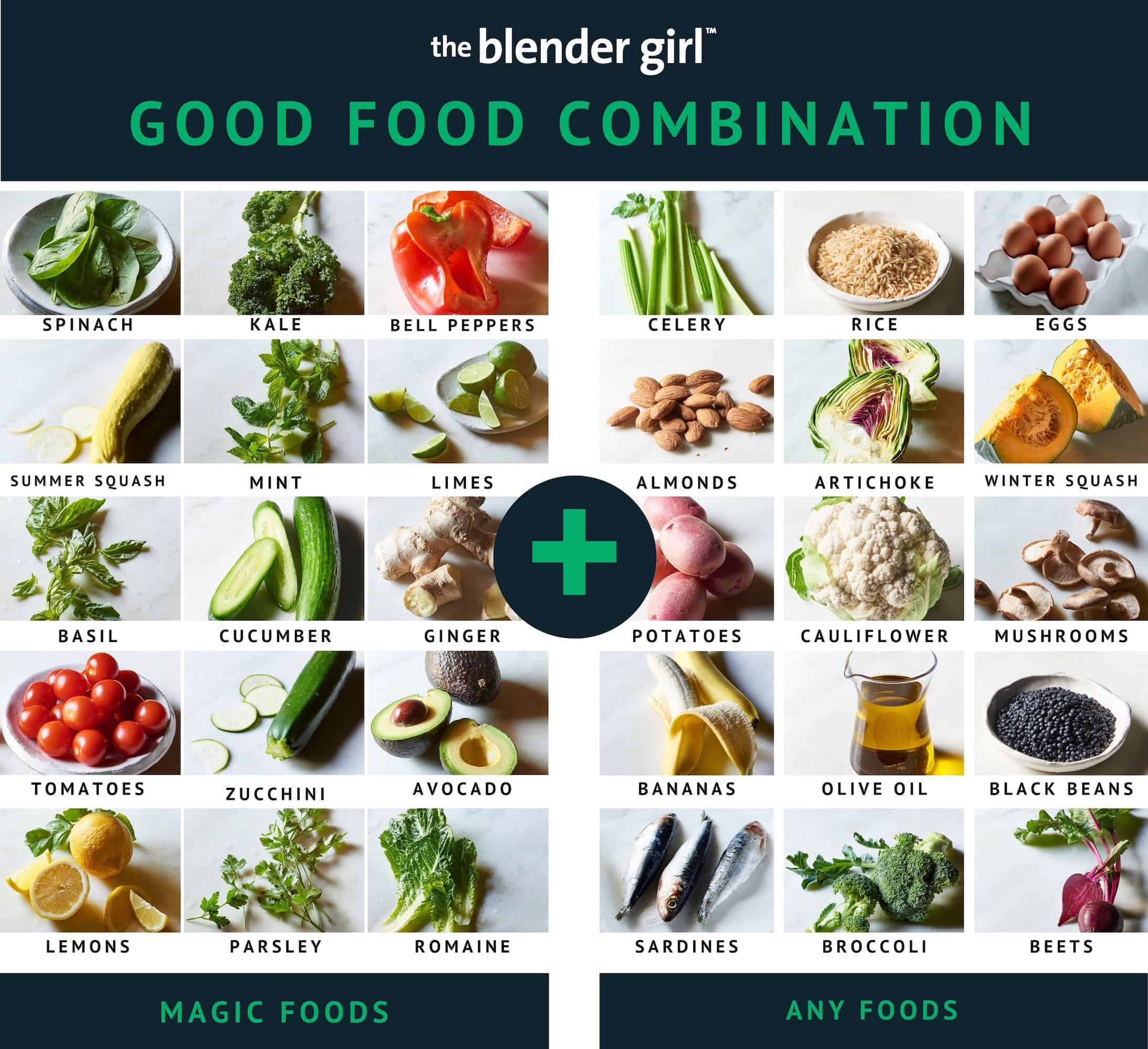
Food Combining Summary
I have been practicing strategic food combining for over 25 years, and it has made a huge difference in my life. My digestion and gut health is so much better, I maintain a healthy weight (even during menopause), I sleep through the night, and I wake up with energy, and all of my markers of health are in the normal ranges.
And, thousands of people that have completed my 60-DAY RESET have also experienced incredible benefits embracing food combining principles.
Here’s the best part:
Food combining does not have to be some dogmatic, restrictive, torturous thing in your life. It is simply a strategy that you can use to improve your digestion, lose weight, and achieve better health.
Food combining may seem like a big hassle. But, once you get the hang of it, it gets easy, and practicing food combining will prompt you to make healthier food choices.
And, when you get into a groove and have a collection of well combined recipes that you are excited to eat, food combining gets even easier!
And, remember: There are flavorful foods that combine well with everything: Vegetable fruits (avocado, tomatoes, bell peppers, summer squashes, zucchini) and leafy greens. So, keep those foods on hand. And, non-starchy vegetables combine well with all foods except fruits. And, they are the healthiest foods that should form the mainstay of your diet anyway!
The "Go-To" Meal
If in doubt, go for Clean Protein and Non-Starchy Veggies.
I am NOT a food combining purist.
Rigid rules just aren’t much fun, and food should be fun, right?!
I pay attention to how different food combinations affect my body, and I respond accordingly.
Food combining doesn’t have to be an “all or nothing” thing.
Here’s my approach: I embrace a flexible approach to food combining. I practice food combining at home, and then dine out with friends and eat traditional food combinations and eat my favorite dishes just like anybody else. (And, boy, do I feel the difference.) But, life is about balance and joy.
Give yourself permission to practice food combining in a way that works for you and your lifestyle and eating preferences.
When you get into a deprivation mindset about food it is not joyful, and extreme approaches lead to patterns of disordered eating.
Take into account your bio-individuality.
Different things work for different people. Food combining sensitivities vary from person to person. Some people are more sensitive to certain food combinations than others.
For example, the saying, “melon on its own or leave it alone” refers to not combining melon with any other food including other fruits.
Melon goes through the body faster than any other food, in about 20 minutes. So, eating melon with other fruits and other foods (as we often do) can cause extreme digestive issues and fermentation.
Some people can tolerate eating melon with other fruits, and other people cannot. (I experience a lot of bloating when I eat melon with other foods.)
Listen to your body.
Notice which food combinations make you feel good, and which combinations do not; and make data-driven decisions about your health in consultation with your doctor and other medical practitioners.
What about added sugars?
A major reason that processed foods have so many adverse side effects is that most contain sugar. We know that added sugars spike blood sugar levels, cause excessive inflammation, damage the liver and kidneys, and feed abnormal cell development in the body.
From a food combining perspective, added sugars combine well with nothing. So, for many reasons, the less added sugar you consume, the sweeter your life will be.
Make food combining easy and fun with delicious recipes!
Practicing food combining is SO much easier when you have a collection of really yummy recipes that you are excited to eat.
And, we have a ton Free Food Combining Recipes on The Blender Girl website.
Give food combining a try!
If you’re anything like the participants in our 60-DAY RESET, you will be amazed at how much better you feel!
DOWNLOAD your FREE Food Combining Charts.

Good and Bad Food Combinations
To make it easier for you to understand the categories of foods, here are some lists.
Here are the good food combinations that support better digestion.
And, I've also listed the food combinations that can cause digestive problems such as gas and bloating.
And, I've made you a little PDF booklet of cheat sheets. The Master Food Combining Sheet is a great thing to print out and post on your fridge or put in your bag to take to restaurants.
DOWNLOAD your FREE Food Combining Charts.
Good Food Combinations
Fruit + Protein Fats
Fruit + Leafy Greens
Animal Protein + Protein Fats
Animal Protein + Non-Starchy Vegetables or Sea Vegetables
Protein Fats + Non-Starchy Vegetables or Sea Vegetables
Dairy (Milk, Cheese) + Non-Starchy Vegetables or Sea Vegetables
Starchy Veg + Non-Starchy Vegetables or Sea Vegetables
Grains + Any Vegetables (Non-Starchy, Starchy, or Sea)
Leafy Greens + Anything
Protein Starches + Non-Starchy Vegetables or Sea Vegetables
Food Combining Stars + Anything
Bad Food Combinations
Fruit + Animal Protein
Fruit + Grains
Fruit + Vegetables (Any)
Animal Protein + Starchy Vegetables
Animal Protein + Grains
Protein Fats + Starchy Vegetables
Protein Fats + Grains
Protein Starches + Animal Protein Or Protein Fats
Added Sugars + Anything
FOOD CATEGORIES
*Here are some general food lists to help you implement the food combining principles.
Star Foods (Magic Foods that pair with any foods)
- avocado
- cucumber
- leafy greens (spinach, kale, arugula, lettuces, chard, beet greens)
- lemons
- limes
- tomato
- bell peppers
- zucchini and summer squash
- wheatgrass
DOWNLOAD your FREE Food Combining Charts.
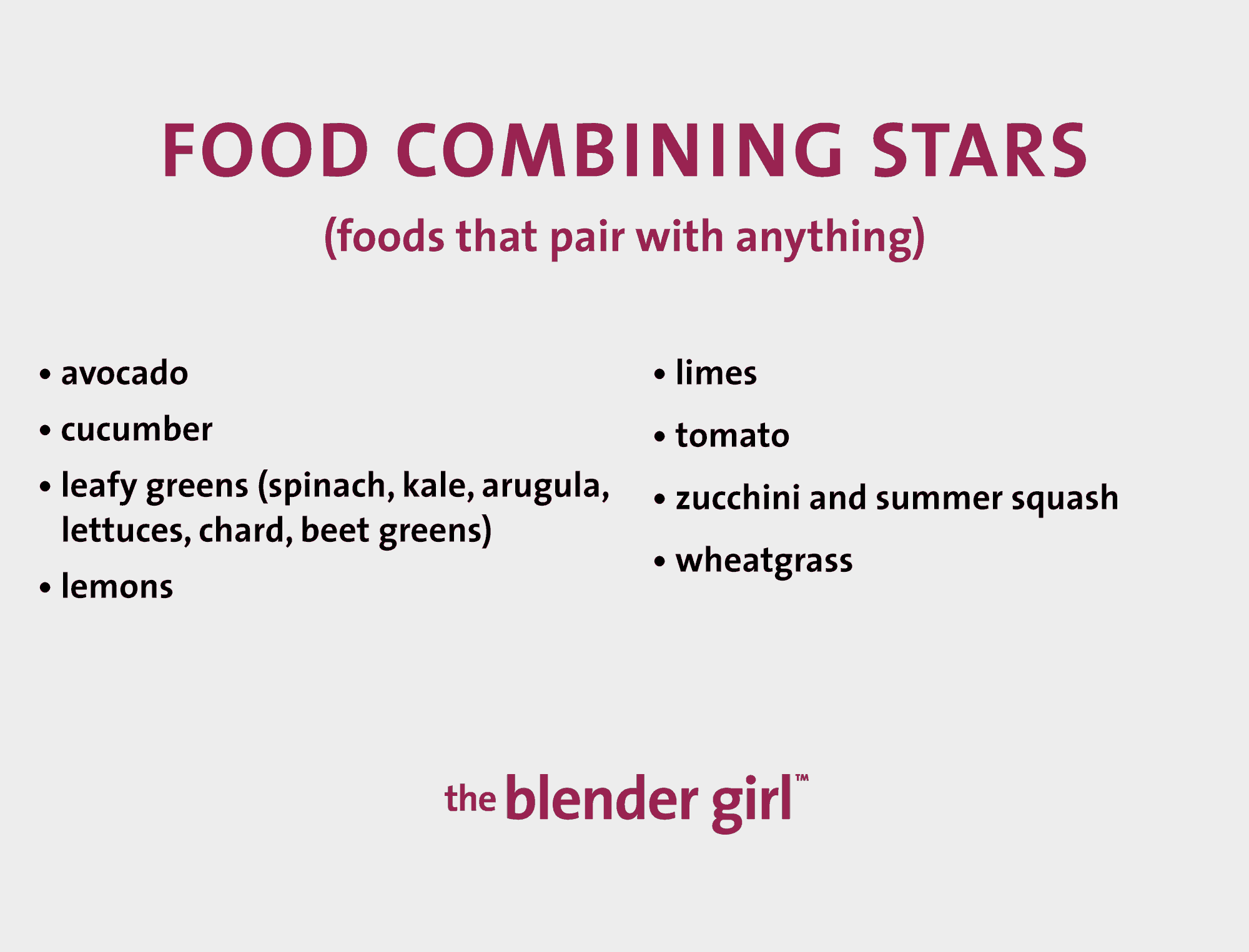
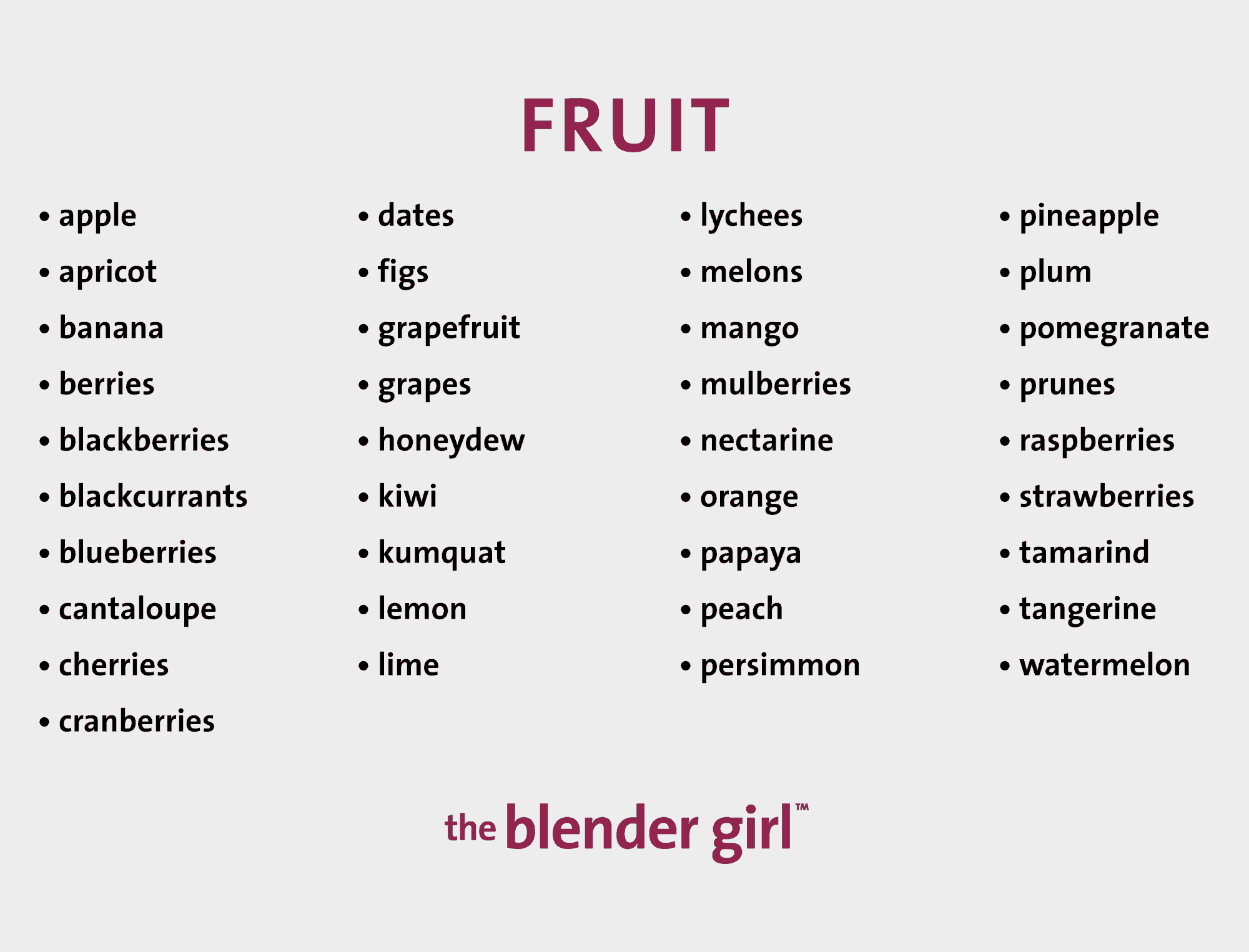
Vegetable Fruits
- avocado
- bell peppers (red, green, orange yellow)
- cucumber
- tomato
- squash and zucchini
Protein Fats
- avocado (magic food)
- cheese
- coconut (magic food)
- kefir
- nuts
- olives (magic food)
- seeds
- yogurt
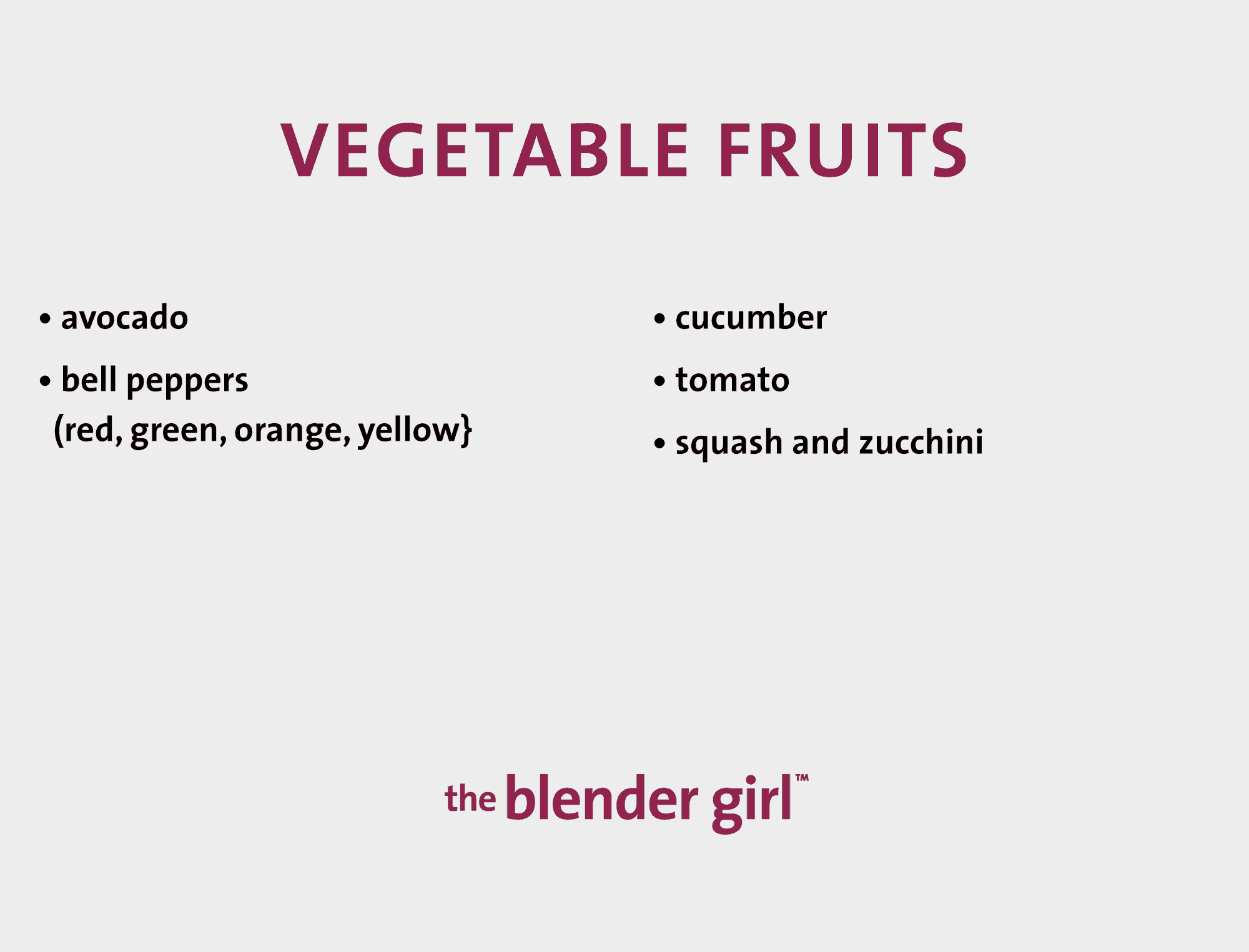
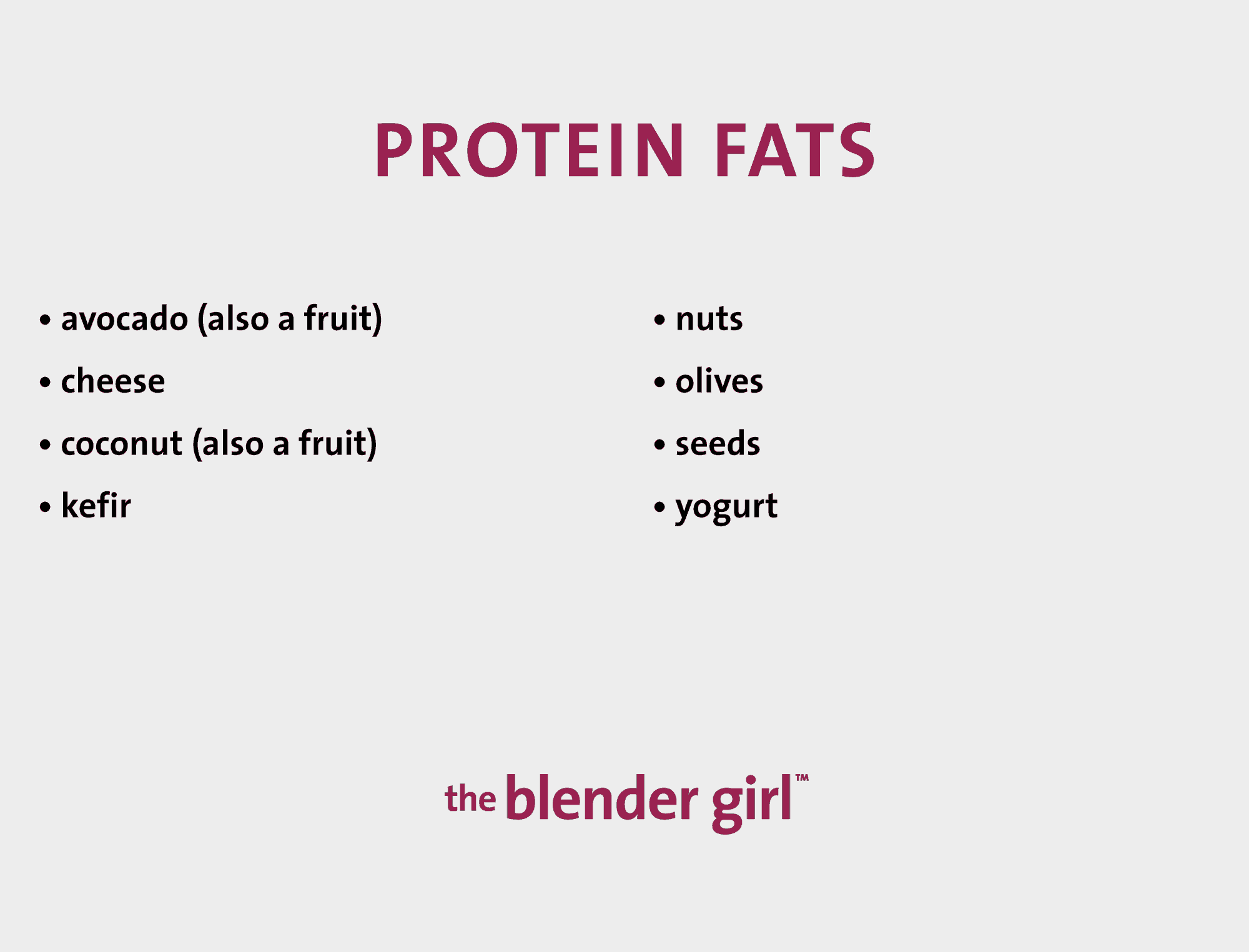
Fruits
- apple
- apricot
- banana
- berries
- blackberries
- blackcurrants
- blueberries
- cantaloupe
- cherries
- cranberries
- dates
- figs
- grapefruit
- grapes
- honeydew
- kiwi
- kumquat
- lemon
- lime
- lychees
- melons
- mango
- mulberries
- nectarine
- orange
- papaya
- peach
- persimmon
- pineapple
- plum
- pomegranate
- prunes
- raspberries
- strawberries
- tamarind
- tangerine
- watermelon
DOWNLOAD your FREE Food Combining Charts.
Protein
- animal (meat, chicken, fish, eggs, dairy)
- beans (protein starches)
- nuts (almonds, cashews, pistachios, walnuts)
- seeds (hemp, chia, flax, pumpkin, sunflower, sesame)
- tempeh
- tofu
DOWNLOAD your FREE Food Combining Charts.
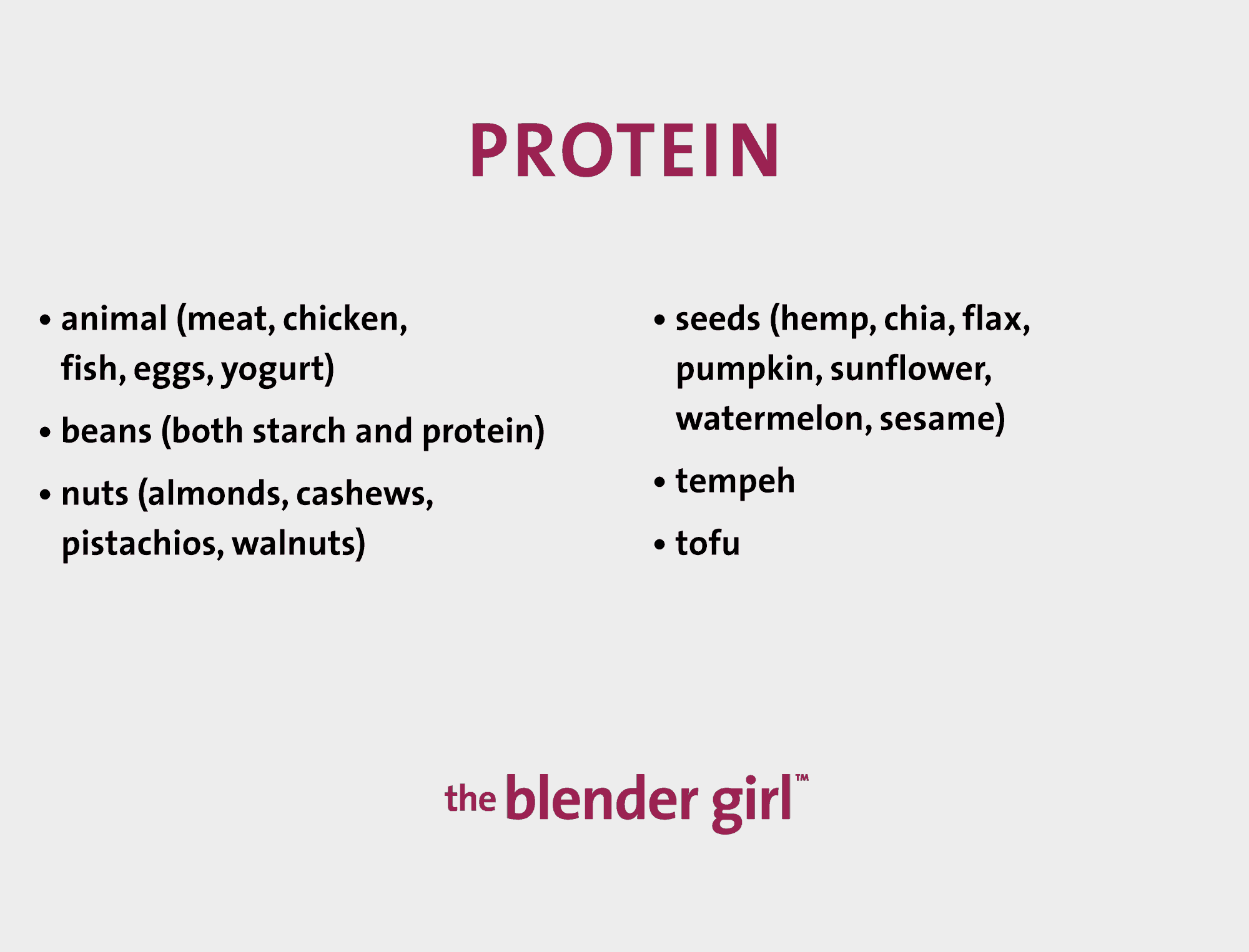
Non-Starchy Vegetables
- arugula (magic food)
- asparagus
- bamboo shoots
- beet greens (magic food)
- bok choy (magic food)
- broccoli
- brussels sprouts
- burdock root
- cabbage
- carrots
- cauliflower
- celeriac
- celery
- chard (magic food)
- chives (magic food)
- collard greens (magic food)
- cucumber (magic food)
- daikon
- dandelion greens (magic food)
- endive (magic food)
- escarole (magic food)
- fennel
- garlic
- green beans
- jicama
- kale (magic f00d)
- kohlrabi
- lamb’s quarters (magic f00d)
- leeks
- lettuce (magic food)
- mustard greens (magic food)
- okra
- onion (white, yellow, purple, green)
- parsley (magic f00d)
- red radishes
- shallots
- spinach (magic food)
- sprouts (magic food)
- turnip
- watercress (magic f0od)
- zucchini (magic food)
DOWNLOAD your FREE Food Combining Charts.
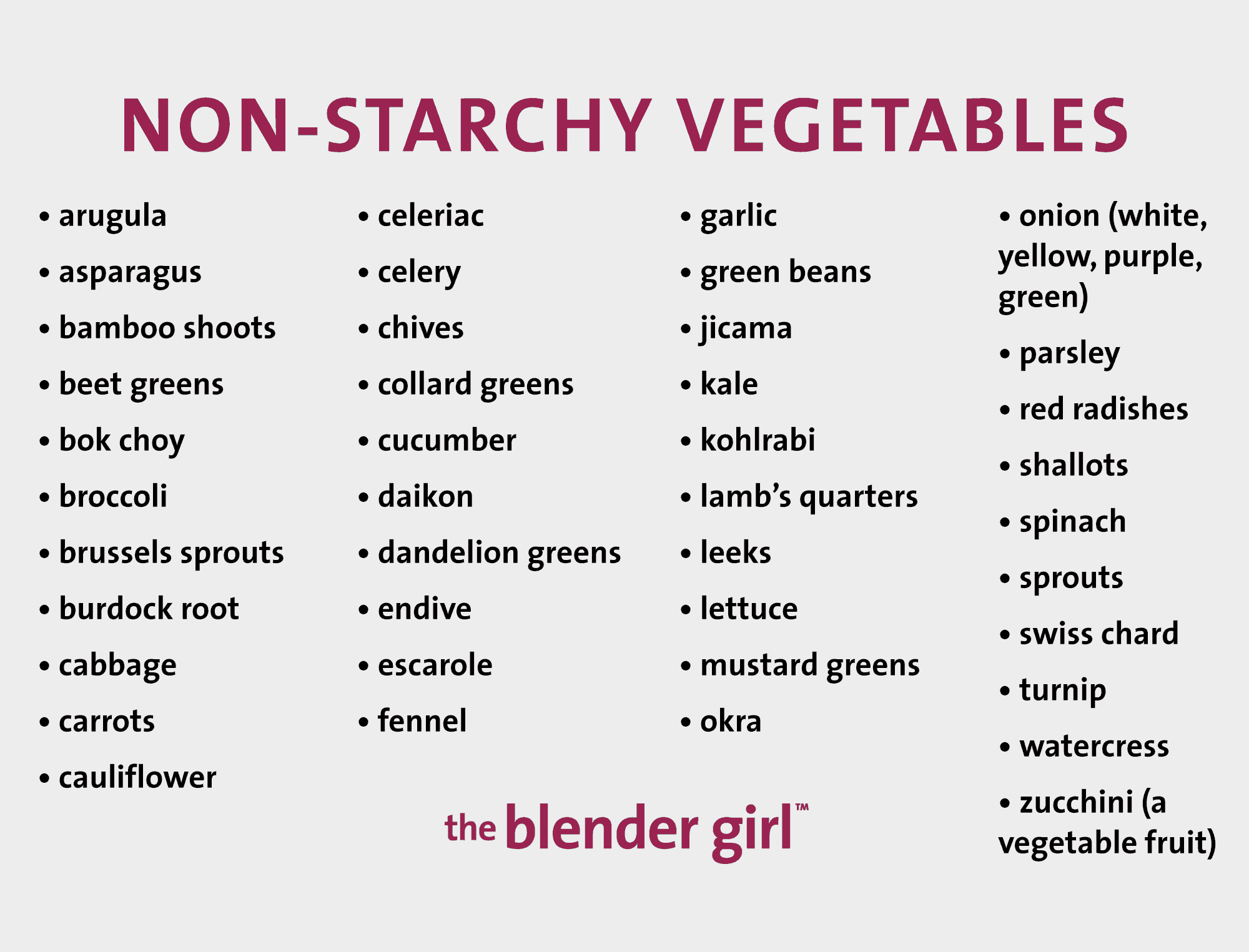
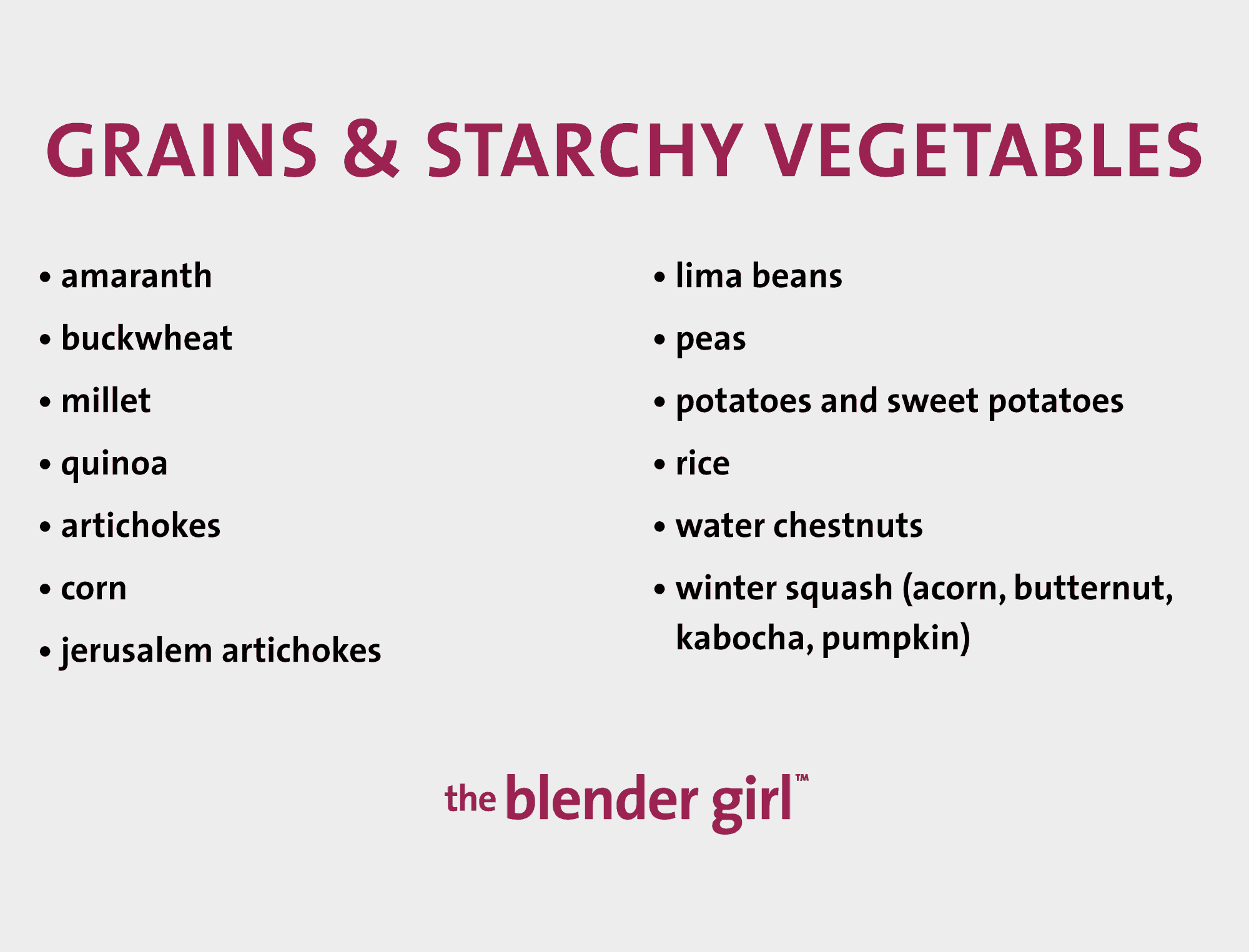
Grains (Pseudo-Grains) and Starchy Vegetables
Grains
- amaranth
- buckwheat
- millet
- oats
- quinoa
- rice
- sorghum
Starchy Vegetables
- artichokes
- beets
- corn
- jerusalem artichokes
- lima beans
- peas
- potatoes and sweet potatoes
- winter squashes (acorn, butternut, kabocha, pumpkin)
Sea Vegetables (Magic Foods)
- agar
- arame
- dulse
- hijiki
- kelp
- kombu
- nori
- wakame
DOWNLOAD your FREE Food Combining Charts.
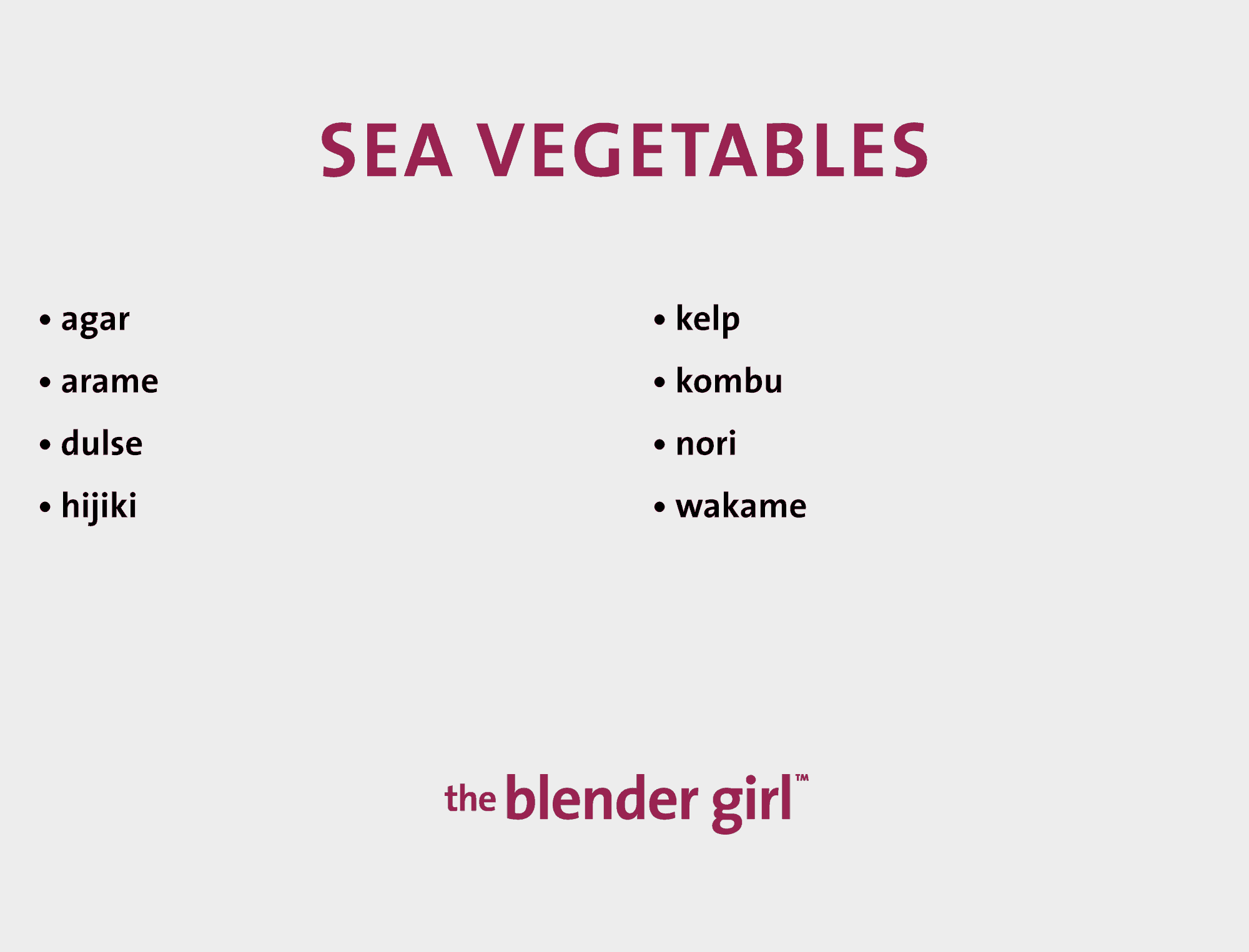
Recommended Reading
Here are some good books to read more about food combining principles.
- The Raw Energy Bible by Leslie Kenton
- Fit For Life by Harvey and Marilyn Diamond
- Food Combining by Lee Dubelle
- Food Combining For Health by Doris Grant and Jean Joice
- Food Combining Made Easy by Dr Herbert Sheldon
DOWNLOAD your FREE Food Combining Charts.



